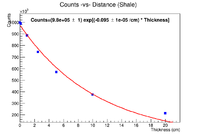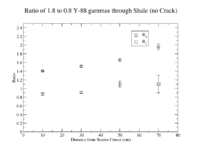TF IsotopeTracers4Cracks
Photon Attenuation in Shale
The attenuation length for a 1.8 MeV photon is 0.16 /cm and 0.895 is 0.22/cm through shale.
File:XCOM attenuation4Shale.pdf
Directing a 1.8 MeV beam of photons in GEANT4 towards various thicknesses of shale produced the graph below.
XCOM predicts an attenuation coefficient of 0.0441 cm^2/g which becomes 0.12/cm when you multiply by the shale density of 2.6 g/cm^3. The fit to GEANT4's predictions above produces a value of 0.1/cm when you plot the number of photons that pass through the shale and still have an energy of 1.8 MeV. A least squares fit gave the parameters
slope=-0.118033 +/- 0.0423836 y-intercept=13.4456 +/- 0.102718
but the curve from these parameters was too low to believe. It is not worth the time right now to figure out what is wrong. The fit by hand which gives 0.1/cm is enough to convince one that GEANT4 is correctly attenuating the photons.
Yittrium in Shale
A simulation of the penetration of the 0.895 and 1.8 MeV photons from Yittrium through shale.
GEANT4 create a point source or 895 keV photon and another with 1800 keV photons iostropically distributed.
A 4" thick piece of shale was placed between the source and the detector.
shale was defined as:
G4Element* O = new G4Element("Oxygen" , "O", z=8., a= 16.00*g/mole);
G4Element* Al = new G4Element("Aluminum" , "Al", z=13., a= 26.98*g/mole);
G4Element* Si = new G4Element("Silicon" , "Si", z=14., a= 28.085*g/mole);
G4Element* H = new G4Element("Hydrogen" , "H", z=1., a= 1.008*g/mole);
G4Material* Shale = new G4Material("Shale", density= 2.6*g/cm3, nel=4);
Shale->AddElement(Al, 15*perCent);
Shale->AddElement(Si, 15*perCent);
Shale->AddElement(O, 38*perCent);
Shale->AddElement(H, 32*perCent);
Two ratios were constructed.

